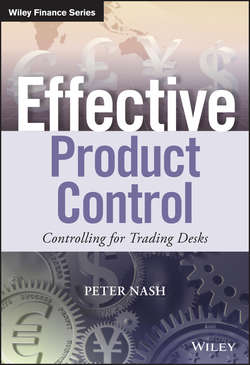Читать книгу Effective Product Control - Nash Peter - Страница 18
На сайте Литреса книга снята с продажи.
Part 1
Working in Product Control
CHAPTER 2
Changing Landscape of Product Control
Greater Levels of Capital
ОглавлениеDuring the GFC it became very evident that banks were not maintaining enough capital to absorb trading losses caused by the significant fluctuations in financial markets and the credit events of companies such as Lehman Brothers. This capital deficiency resulted in many banks having to seek support from their governments to prevent their collapse.
Governments across the world were very aware of their need to protect the savings of investors and prevent the crisis from damaging real businesses (i.e., companies outside of financial services, such as manufacturers, retail, etc.) which require loans from banks to fund their working capital and investments. Consequently, the reaction from governments was significant. For example, in the United States the government passed legislation, the Emergency Economic Stabilization Act 2008, to support the purchase of up to $700 billion of troubled assets from banks (TARP). In Australia, the banks benefited from the government's guarantee on deposits and wholesale funding requirements for Australian deposit-taking institutions. Governments across Europe also effected similar measures.
As a result of this shock, the Bank for International Settlements (BIS) commenced with the design of Basel III, which sought to address the shortcomings in capital requirements that occurred during the GFC. If we fast-forward to today, we can observe that through Basel III, the Fundamental Review of the Trading Book (FRTB) and independent regulatory intervention, the levels of capital that banks now (and will) hold are higher than prior to the GFC. This has forced banks to be more deliberate about the size and quality of their assets, credit risk and the size and complexity of their market risk.
The businesses Product Control support are now being evaluated not only on their accounting P&L, but also on their P&L performance after considering capital costs. There are various measurements used in the industry to assess capital adjusted returns, one measure is economic P&L. Economic P&L takes a business's net operating profit after tax (NPAT) and deducts a cost of capital.
Economic P&L = NPAT − (capital employed × cost of capital)
NPAT is the P&L product control report to the desk after being adjusted for tax and non-trading costs. The cost of capital is the cost of maintaining the necessary levels of debt and equity that comprise the capital base.
For example, if a bank has issued $1 billion of ordinary shares, the cost of this capital is the return shareholders require on their equity investment in the bank (i.e., dividends and capital growth). That return is market driven and may be a per annum amount of 10 %, 12 %, 15 % and so on. For example, the rates desk used $200 million of capital to invest in sales and trading activities, which generated an NPAT of $80 million for the year. If the cost of capital is deemed to be 10 %, the economic P&L for the year would be:
As capital levels generally rise with increased risk, if a business increases risk, such as taking on more risk weighted assets, it will place downward pressure on economic P&L (as depicted in Figure 2.3).
Figure 2.3 The impact of increased capital
This focus on capital has led to product control spending more time reviewing the balance sheet, identifying and explaining significant changes in risk-weighted assets (RWA) and partnering with the business to help reduce unwanted increases in the balance sheet.
